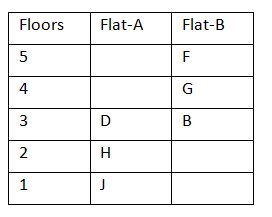Question
F lives to the north east of
___. Answer the questions based on the information given below: Ten persons (A, B, C, D, E, F, G, H, I and J) live on 10 different flats of a 5 storey building, where the bottommost floor is 1 and the floor above is 2 and so on. There are 2 types of flats on each floor, flat A and flat B such that flat A is in the west of flat B. Flat A of floor 1 is immediately below of flat A of floor 2, which is immediately below of flat A of floor 3 and so on, similarly for flat B. The dimensions of each of the flats is same There are two floors between the floors of J and G (both of them may or may not live in the same type of flat). J lives on first floor. J lives south west of B. F lives 2 floors above B (both live in the same type of flat). D lives immediately above floor H, who doesn’t live anywhere below B’s floor. A lives above D’s floor but not in flat A. E doesn’t live on a prime numbered floor. C doesn’t live immediately above B.Solution
There are two floors between the floors of J and G (both of them may or may not live in the same type of flat). J lives south west of B. J lives on first floor. F lives 2 floors above B (both live in the same type of flat). D lives immediately above H, who doesn’t live below anywhere B’s floor. So, G must live above J’s floor either in flat A or B. Both F and B live in flat B. Case 1: When G lives in the flat B.  Case 2(a): When both G and J live in the same flat and J lives on 1st floor. H doesn’t live below B’s floor, so this case is not possible.
Case 2(a): When both G and J live in the same flat and J lives on 1st floor. H doesn’t live below B’s floor, so this case is not possible.  A lives above D’s floor but not in flat A. E doesn’t live in a prime numbered floor. C doesn’t live immediately above B. So, A lives in on 5th floor in flat B. Case 2(b): When both G and J live in the same flat and J live on 1st floor. The final arrangement is as follows:
A lives above D’s floor but not in flat A. E doesn’t live in a prime numbered floor. C doesn’t live immediately above B. So, A lives in on 5th floor in flat B. Case 2(b): When both G and J live in the same flat and J live on 1st floor. The final arrangement is as follows: 
Choose the word which is the most opposite in meaning to the word ‘insinuating’ as used in the passage .
Choose the word/group of words which is most similar in meaning to the word/ group of words printed in bold as used in passage
FORGING
...Which of the following is opposite in the meaning of the word ‘initiative’ as used in the passage?
Which of the following is true regarding schemes like PMMY?
(i) these schemes mainly help farm activities.
(ii) they fund manufacturing, t...
Which of the following is the theme of the passage?
What does the survey argue against?
I. Sudden stall of the stock prices
II. Setting of targets which are very difficult to achieve
...What danger is mentioned in the passage?
Which of the following is the important manifestation of the RBI’s prognosis for growth?
Select the option which seems nearest in meaning to the phrase 'beyond the horizon' as mentioned in the passage.
Which of the following is/are true according to the passage?
(i) 10 years ago, tourism was not at all developed in developing countries, and i...
Relevant for Exams:


